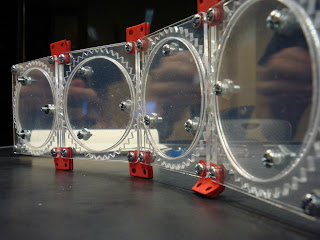


Light Study through Layered Radiant Light Film and Plexiglas

As the light film is placed at different angles towards the incoming light, it produces an array of colors, dependent on the way the light strikes the material. The addition of a polarized layer will create the possibility of the surface to morph on itself as it moves. The polarized layer will establish different angles at which the light passing through can be seen by the viewer.
Diagrammatic structure studies


Prototype 1

Prototype 2
This prototype expands on prototype 1 by adding a new axis of motion as each cell rotates in its position. The rotation when combined with the polarized film, will create different viewing experiences as light seemingly pulses through the structure.


Prototype 3
This prototype uses the same basic structure established in the previous prototype. This prototype took into account the possibility of creating a facade for a building. A tension membrane layer was added to dampen the light coming through the structure and into the building to create a less intense lighting environment for occupants. The fabric would adjust in height above the glass surface to create varying color arrays cast on it as sunlight passes through the radiant light film.


Prototype 4


Prototype 5

No hay comentarios:
Publicar un comentario